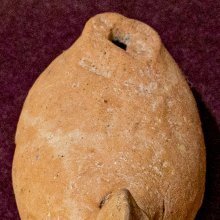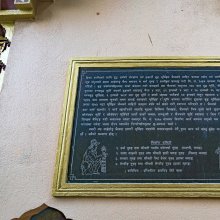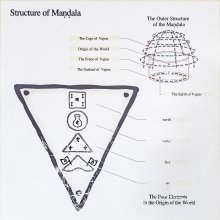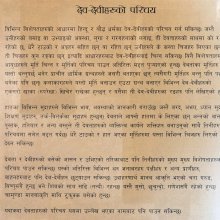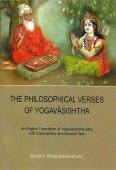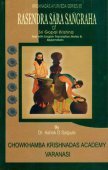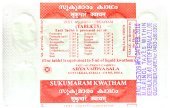Cara, Cāra: 31 definitions
Introduction:
Cara means something in Hinduism, Sanskrit, Jainism, Prakrit, Buddhism, Pali, the history of ancient India, Marathi, Hindi, biology, Tamil. If you want to know the exact meaning, history, etymology or English translation of this term then check out the descriptions on this page. Add your comment or reference to a book if you want to contribute to this summary article.
Alternative spellings of this word include Chara.
Images (photo gallery)
In Hinduism
Dharmashastra (religious law)
Source: Wisdom Library: Dharma-śāstraCāra (चार) refers to “spy” (a man who, keeping his real character concealed, comes to know what is done and what is not done by others). The word is used throughout Dharmaśāstra literature such as the Manusmṛti. (See the Manubhāṣya 8.116)

Dharmashastra (धर्मशास्त्र, dharmaśāstra) contains the instructions (shastra) regarding religious conduct of livelihood (dharma), ceremonies, jurisprudence (study of law) and more. It is categorized as smriti, an important and authoritative selection of books dealing with the Hindu lifestyle.
Purana and Itihasa (epic history)
Source: Cologne Digital Sanskrit Dictionaries: The Purana Index1) Cara (चर).—A son of Devajani, a Yakṣa.*
- * Brahmāṇḍa-purāṇa III. 7. 128.
2) Cāra (चार).—The spy in different disguises to be sent over his kingdom and that of the enemy; king not to act on the report of a single Cāra; the source of the kingdom; Cāracakṣu is the king.*
- * Brahmāṇḍa-purāṇa IV. 21. 51 and 64; 25. 12. Matsya-purāṇa 215. 90-6; 226. 12.

The Purana (पुराण, purāṇas) refers to Sanskrit literature preserving ancient India’s vast cultural history, including historical legends, religious ceremonies, various arts and sciences. The eighteen mahapuranas total over 400,000 shlokas (metrical couplets) and date to at least several centuries BCE.
Jyotisha (astronomy and astrology)
Source: Wisdom Library: Brihat Samhita by VarahamihiraCara (चर) refers to “spies” (working for the king), according to the Bṛhatsaṃhitā (chapter 2), an encyclopedic Sanskrit work written by Varāhamihira mainly focusing on the science of ancient Indian astronomy astronomy (Jyotiṣa).—Accordingly, “We shall now proceed to give a brief description of (the qualifications of) a jyotiṣaka. [...] He must be able to interpret the language and gestures of fighting men and the like; he must be learned in the Ṣaḍguṇa and Upāya policies; he must be able to predict the success or failure of an undertaking; he must be able to interpret omens; he must have a knowledge of favourable halting places for the king’s army; he must be able to interpret the colour of ceremonial fires; he must know when to employ the ministers, spies [i.e., cara], messengers and forest men; he must be able to give directions touching the captures of the enemy’s fortress”.
Source: Wikibooks (hi): Sanskrit Technical TermsCara (चर).—Ascensional difference. It is defined by the arc of the celestial equator lying between the six o'clock circle and the hour circle of a heavenly body at rising. Note: Cara is a Sanskrit technical term used in ancient Indian sciences such as Astronomy, Mathematics and Geometry.
Source: INSA Digital Repository: Determination of Ascensional Difference in the LagnaprakaranaCara (चर) refers to the “ascensional difference” and represents an important astronomical element that is involved in a variety of computations related to diurnal problems. It is essentially the difference between the right ascension and the oblique ascension of a body measured in time units. At the time of rising, the cara gives the time interval taken by a body to traverse between the horizon and the six o’ clock circle or vice-versa depending upon whether the declination of the body is positive or negative. It is most commonly determined for the Sun because it is this quantity that helps one in finding the time of sunrise and sunset at a given location, for a given time of the year. It is also used in the determination.
Remarks regarding the nature of the cara function from a mathematical viewpoint: (i) the cara has to be computed successively during every third part, or fifth part etc. of the day, and (ii) the variation in cara cannot be taken to be proportional to the change in time for setting the clock.—It seems to us that the intent of the author here is to caution against assuming a linear variation in cara from sunrise to noon, and also from noon to sunset. This prescription to determine cara successively at various intervals during the day, and not to apply the method of proportion while setting the clock is quite interesting and gives us a clue to the fact that the day—irrespective of its duration—was divided into a fixed number of units, for certain purposes. Clearly, the duration of each such unit would vary over the course of the year along with day length, as indicated by the following verse of Śrīpati: “Muhūrta is that [span of time] which is [equal to] one fifteenth of a day; and also of the night similarly”.

Jyotisha (ज्योतिष, jyotiṣa or jyotish) refers to ‘astronomy’ or “Vedic astrology” and represents the fifth of the six Vedangas (additional sciences to be studied along with the Vedas). Jyotisha concerns itself with the study and prediction of the movements of celestial bodies, in order to calculate the auspicious time for rituals and ceremonies.
Shaktism (Shakta philosophy)
Source: Google Books: Manthanabhairavatantram1) Cāra (चार) refers to “actions” (cf. Cara, ‘movement’), according to the Śrīmatottara-tantra, an expansion of the Kubjikāmatatantra: the earliest popular and most authoritative Tantra of the Kubjikā cult.—Accordingly, “By the practice of the Yoga of Stillness [i.e., nirācārayoga], one obtains the fruit. She whose nature is movement (cara) moves, (and her movement is) divided into (downward) motion (cāra) and upward motion (uccāra). That should be known as Stillness (nirācāra). Stillness is not other (than this). (This is) where actions (cāra) cease along with the activities (karman) of speech, mind, and body. When a pure (nirmala) state arises, that is said to be Stillness”.
2) Cāra (चार) refers to the “motionless” quality of the Void, according to the Manthānabhairavatantra, a vast sprawling work that belongs to a corpus of Tantric texts concerned with the worship of the goddess Kubjikā.—Accorindly, as the God teaches the Goddess how to make mantras effective: “Contemplate the Void that is the Self at one with you and, established in the lotus of the heart, (shines) like pure crystal, motionless (cāra) and devoid of utterance (uccāra), burning with its own radiant energy (tejas). (Contemplate it) rising like the solar orb by means of (the rise of Kuṇḍalinī which is) the Yoga of the practice of Suṣumṇā. [...]”.
3) Cāra (चार) refers to the “movement” (i.e., activity of the vital breath), according to the Ṣaṭsāhasrasaṃhitā, an expansion of the Kubjikāmatatantra: the earliest popular and most authoritative Tantra of the Kubjikā cult.—Accordingly, “Mālinī of the Void (vyomamālinī) abides (both) as one and as many divisions (vibhāga). The End of the Twelve is the Void which (is the abode of Mālinī that, as) the Self, is the nectar (Mālinī showers down below). (Thus Mālinī) resides in the midst of the ocean of nectar and, residing in the movement (cāra) (of the vital breath) [i.e., cāra-stha], she is the one who impels (its) motion (cāravāhinī). 'Movement' is said to be the activity of the vital breath (prāṇagati). Thus she who, residing there, impels (it, is said to be) the one who impels (its) motion (cāravāhinī)”.

Shakta (शाक्त, śākta) or Shaktism (śāktism) represents a tradition of Hinduism where the Goddess (Devi) is revered and worshipped. Shakta literature includes a range of scriptures, including various Agamas and Tantras, although its roots may be traced back to the Vedas.
Yoga (school of philosophy)
Source: ORA: Amanaska (king of all yogas): A Critical Edition and Annotated Translation by Jason BirchCara (चर) refers to “moving (things)”, according to the Viṣṇudharma verse 96.1 and 4.—Accordingly, “O Brahmin, you mentioned that this Brahma is eternal and from it this whole world [consisting of] moving (cara) and unmoving [things] arose [...]. Therefore, how could the [ever-changing] world arise from the eternal and omnipresent [Brahma], which is free from transformation and even devoid of quality?”.

Yoga is originally considered a branch of Hindu philosophy (astika), but both ancient and modern Yoga combine the physical, mental and spiritual. Yoga teaches various physical techniques also known as āsanas (postures), used for various purposes (eg., meditation, contemplation, relaxation).
Vedanta (school of philosophy)
Source: ORA: Amanaska (king of all yogas): (Advaita Vedanta)Cara (चर) refers to “whatever is moving”, according to the Māṇḍūkyopaniṣatkārikā 3.31-32.—Accordingly, while discussing duality and mental activity: “All this duality which is [comprising of] whatever is moving (cara) and motionless is [just] a visible object of the mind. For when [the state of] no-mind of mind [arises], duality is not perceived. [Why is this?] When the mind does not conceptualize because [one has] realized the truth of the self, then, it goes to the state of no mind. Therefore, in the absence of perceivable objects, there is no perception [of duality]”.

Vedanta (वेदान्त, vedānta) refers to a school of orthodox Hindu philosophy (astika), drawing its subject-matter from the Upanishads. There are a number of sub-schools of Vedanta, however all of them expound on the basic teaching of the ultimate reality (brahman) and liberation (moksha) of the individual soul (atman).
Sports, Arts and Entertainment (wordly enjoyments)
Source: archive.org: Syainika Sastra of Rudradeva with English Translation (art)1) Cāra (चार) refers to “spies”, according to the Śyainika-śāstra: a Sanskrit treatise dealing with the divisions and benefits of Hunting and Hawking, written by Rājā Rudradeva (or Candradeva) in possibly the 13th century.—Accordingly, “[...] It has been said that there are eighteen addictions. These are the outcome of the desire for earthly enjovments. [...] Fault-finding is defined as divulgence of other people’s faults. This should be carefully heard from spies (cāra-mukhatas): and then the course of action determined after deliberation within oneself, and the needful done by trusted emissaries. [...]”.
2) Cārā (चारा) refers to the “amorous gait” (in dancing), according to the Śyainika-śāstra.—Accordingly, “[...] It has been said that there are eighteen addictions. These are the outcome of the desire for earthly enjovments. [...] Dancing is of two kinds—the wild, called tāṇḍava, and the theatrical, called lāsya. It is accompanied with chārī or amorous gait [e.g., cārā] and laya or keeping time. [...]”.

This section covers the skills and profiencies of the Kalas (“performing arts”) and Shastras (“sciences”) involving ancient Indian traditions of sports, games, arts, entertainment, love-making and other means of wordly enjoyments. Traditionally these topics were dealt with in Sanskrit treatises explaing the philosophy and the justification of enjoying the pleasures of the senses.
In Jainism
General definition (in Jainism)
Source: The University of Sydney: A study of the Twelve ReflectionsCara (चर) refers to “mobile” (beings), according to the 11th century Jñānārṇava, a treatise on Jain Yoga in roughly 2200 Sanskrit verses composed by Śubhacandra.—Accordingly, “The doctrine protects all [beings] that are mobile and immobile (cara-acara) with regard to the occurrence of misfortune. It also comforts [them] completely with a stream of the liquid ambrosia of happiness. The rain clouds, wind, sun, moon, earth, ocean and Indra—those, which are protected by the doctrine, are of service to the whole world”.

Jainism is an Indian religion of Dharma whose doctrine revolves around harmlessness (ahimsa) towards every living being. The two major branches (Digambara and Svetambara) of Jainism stimulate self-control (or, shramana, ‘self-reliance’) and spiritual development through a path of peace for the soul to progess to the ultimate goal.
India history and geography
Source: Cologne Digital Sanskrit Dictionaries: Indian Epigraphical GlossaryCara.—(CII 4), a spy. Note: cara is defined in the “Indian epigraphical glossary” as it can be found on ancient inscriptions commonly written in Sanskrit, Prakrit or Dravidian languages.
--- OR ---
Cāra.—(IE 8-3; EI 26), a spy; same as Cara; sometimes used in place of Cāṭa. (EI 15), cf. a-cāra-asana-carm-āṅgāra (IE 8-5), probably, passage [of royal officers through a village]; cf. also a-pār- āsana-carm-āṅgāra with pāra (probably, ferrying) instead of cāra. Note: cāra is defined in the “Indian epigraphical glossary” as it can be found on ancient inscriptions commonly written in Sanskrit, Prakrit or Dravidian languages.

The history of India traces the identification of countries, villages, towns and other regions of India, as well as mythology, zoology, royal dynasties, rulers, tribes, local festivities and traditions and regional languages. Ancient India enjoyed religious freedom and encourages the path of Dharma, a concept common to Buddhism, Hinduism, and Jainism.
Biology (plants and animals)
Source: Google Books: CRC World Dictionary (Regional names)1) Cara in India is the name of a plant defined with Buchanania angustifolia in various botanical sources. This page contains potential references in Ayurveda, modern medicine, and other folk traditions or local practices It has the synonym Buchanania angustifolia Benth., nom. illeg. (among others).
2) Cara is also identified with Buchanania lanzan It has the synonym Buchanania latifolia Roxb..
3) Cara is also identified with Buchanania latifolia.
Example references for further research on medicinal uses or toxicity (see latin names for full list):
· Plants of the Coast of Coromandel (1820)
· Journal für die Botanik (1800)
· Flora Indica (1832)
· J. Sci. Food Agric. (1977)
· Journal of Tree Sciences (1984)
· Taxon (1979)
If you are looking for specific details regarding Cara, for example health benefits, extract dosage, pregnancy safety, diet and recipes, side effects, chemical composition, have a look at these references.

This sections includes definitions from the five kingdoms of living things: Animals, Plants, Fungi, Protists and Monera. It will include both the official binomial nomenclature (scientific names usually in Latin) as well as regional spellings and variants.
Languages of India and abroad
Pali-English dictionary
Source: BuddhaSasana: Concise Pali-English Dictionarycara : one who walks or frequents; 2. a spy. || cāra (m.), motion; action; process; going.
Source: Sutta: The Pali Text Society's Pali-English DictionaryCāra, (fr. car carati to move about) motion, walking, going; doing, behaviour, action, process Miln. 162 (+vihāra); Dhs. 8=85 (=vicāra); DhsA. 167. Usually —° (n. & adj.): kāma° going at will J. IV, 261; pamāda° a slothful life J. I, 9; piṇḍa° alms-begging Sn. 414, 708; sabbaratti° wandering all night S. I, 201; samavattha° A. III, 257. See also carati Ib.
— or —
Cara, (n-adj.) (from car, carati) 1. the act of going about, walking; one who walks or lives (usually —°): oka° living in water M. I, 117; J. VI, 416; antara° S. IV, 173; eka° solitary Sn. 166; saddhiṃ° a companion Sn. 45; anattha° J. V, 433; jala° Dāvs. IV, 38. See also cāreti & gocara.—Instr. carasā (adv.) walking M. I, 449.—cara-vāda “going about talk,” gossip, idle talk S. III, 12; V, 419.—sucara easy, duccara difficult Vin. III, 26.—2. one who is sent on a message, a secret emissary, a spy S. I, 79. Also as carapurisa J. II, 404; IV, 343; VI, 469; DhA. I, 193. ‹-› Note.—cara-purāya at A. V, 133 should be changed into v. l. SS paramparāya. (Page 262)

Pali is the language of the Tipiṭaka, which is the sacred canon of Theravāda Buddhism and contains much of the Buddha’s speech. Closeley related to Sanskrit, both languages are used interchangeably between religions.
Marathi-English dictionary
Source: DDSA: The Molesworth Marathi and English Dictionarycara (चर).—n (S) The difference of time between the rising of a heavenly body at laṅkā (over which the first meridian passes), and that of its rising at any particular place, ascensional difference. 2 In astrology. Monday.
--- OR ---
cara (चर).—a (S) Locomotive, moving, going. Ex. caradravya Moveables, goods and chattels; jalacara water-going; khacara heaven-going; bhūcara, vanacara &c. 2 An epithet for certain mansions of the moon and for a division of the signs of the zodiac; viz. for Aries, Cancer, Libra, Capricornus. Whatever is to be accomplished with expedition is to be done under these signs; but not that of which the permanency is desired. Of the lunar asterisms, of the signs of the zodiac, of the lagma or signs of the oblique ascension, and of the vēḷā or divisions of time, three departments are made, named severally cara or carasvabhāva, sthira or sthira svabhāva, & dvisvabhāva, moving, stationary, partaking of the two. The cara signs are mēṣa, karka, tulā, makara; the sthira signs are vṛṣabha, siṃha, kumbha, vṛścika; the dvisvabhāva are mithuna, kanyā, dhana, mīna. 3 Laxly. That is on the move or wing; that is about to start.
--- OR ---
cara (चर).—m ( H) A ditch round a fort, a moat; a long trench or channel gen. 2 m f A scratch or mark (as made by scouring or rubbing). v paḍa.
--- OR ---
cara (चर).—m (caraṇēṃ or cāraṇa S) Spreading (as of an ulcer or a sore, as of a liquor under capillary attraction). v ghē.
--- OR ---
carā (चरा).—m A scratch (as from scouring or rubbing): also a jag (as of a blade).
--- OR ---
cāra (चार).—m pl or by redup. cāracāra m pl (ācāra S Conduct.) Light habits or ways; mischievous or idle tricks, pranks, frolics: ex. tyajuni cāra vicāra karī barā ("ceasing from evil, may learn to do well. " Is. i. 16, 17): also airs, manners, freaks, fancies, whimsies, dainty or delicate ways. v kara. 2 Splicing, splice, splicedness; i. e. the act, the work wrought, or the state effected. cārā cārānīṃ or cārēṃ cārēṃ Daintily, delicately, nicely, squeamishly; with finikin, fastidious, or fanciful airs and ways. Used with jēva, khā, pi, bōla, cāla, liha &c.
--- OR ---
cāra (चार).—f Young green grass. 2 Any thing green (leaves &c.) considered as food for cattle. 3 m A tree, Chirongia sapida, or, according to Graham, Buchanania latifolia. 4 The shreds or filamentous substance around the pulp of the jack. 5 n R The seed of Chirongia sapida. 6 An inferior kind of bāraphaḷa or jujube. The tree is called cārācēṃ jhāḍa.
--- OR ---
cāra (चार).—m S A spy, scout, secret emissary. 2 A messenger; a herald.
--- OR ---
cāra (चार).—a (Char. catura S) Four. 2 Used to express a moderate number or quantity. Ex. tyālā cāra gōṣṭī samajavūna sāṅga; tyācē javaḷa cāra paisē āhēta. cāra gōṣṭī lāvaṇēṃ or karaṇēṃ To start perverse objections or demurrings. cāra gōṣṭī sāṅgaṇēṃ To use pacificatory or persuasive arguments or explanations. cāra ghēṇēṃ cāra dēṇēṃ Phrase expressive of sociality and neighborliness. (Readiness to give and to take, to do and to be done for.) cāra hāta hōṇēṃ g. of s. reciprocally. (To come to handling of each other.) To come to scuffling or fisticuffs;--used of two persons.
--- OR ---
cāra (चार).—ind (cāra Green grass.) An enhancing adjunct to hiravā, as hiravācāra Dark green.
--- OR ---
cārā (चारा).—m ( H) Food for beasts and birds. (Grass, leaves, grains, worms &c., yet esp. understood of Grass.) Ex. gaganīṃ lāgalā kōsalā || cārā kōṇa puravī tyālā ||.
--- OR ---
cāra (चार).—a Add:--This word, written as cāraṃ or cyāraṃ, from the Persian Fourth, is much used in papers of Revenue, in the sense of (Land or soil) of the fourth quality.
Source: DDSA: The Aryabhusan school dictionary, Marathi-Englishcara (चर).—a Locomotive, moving, going. cara- dravya Moveables, goods and chattels.
--- OR ---
cara (चर).—m A ditch round a fort, a moat. A scratch or mark.
--- OR ---
carā (चरा).—m A scratch (as from scouring or rubbing): also a jag (as of a blade).
--- OR ---
cāra (चार).—a Four; a moderate number or quan- tity. cārī diśā mōkaḷyā hōṇēṃ To have the wild world open before one. cārī vāṭā mōkaḷyā Atlarge. cāra divasa sāsūcē cāra divasa sunēcē Every dog has his day. cārāñcārānnī Delicately; with fastidious airs. cāra gōṣṭī sāṅgaṇē To persuade or pacify. cāra ghēṇēṃ cāra dēṇēṃ To be freely social; to give and take. cāra hāta hōṇēṃ To come to an altercation.
--- OR ---
cāra (चार).—m A spy. A herald. f Young green grass. m pl Light habits.
--- OR ---
cārā (चारा).—m Food for beasts and birds.
Marathi is an Indo-European language having over 70 million native speakers people in (predominantly) Maharashtra India. Marathi, like many other Indo-Aryan languages, evolved from early forms of Prakrit, which itself is a subset of Sanskrit, one of the most ancient languages of the world.
Sanskrit dictionary
Source: DDSA: The practical Sanskrit-English dictionaryCara (चर).—a. (-rī f.) [चर्-अच् (car-ac)]
1) Moving, going, walking, grazing &c.; धर्मारण्यचरेषु प्राणिषु (dharmāraṇyacareṣu prāṇiṣu) Ś.5.9.
2) Following, practising (at the end of comp.).
3) Trembling, shaking.
4) Movable; see चराचर (carācara) below; Manusmṛti 3.21; Bhagavadgītā (Bombay) 13.15.
5) Animate; Manusmṛti 5.29;7.15.
6) (Used as an affix) formerly, late; आढ्यचर (āḍhyacara) 'one who was formerly rich' so देवदत्तचर, अध्यापकचर (devadattacara, adhyāpakacara) late teacher &c.
-raḥ 1 A spy.
2) A wagtail.
3) A game played with dice and men.
4) A cowrie.
5) The planet Mars.
6) (Hence) Tuesday.
7) The seventh Karaṇa in astrology.
8) The Karaṇas taken collectively.
9) The difference of time between two meridians.
1) The first, fourth, seventh, and tenth signs of the zodiac.
11) The wind; क्वाहं तमो- महदहंखचराग्निवार्भूसंवेष्टिताण्डघटसप्तवितस्तिकायः (kvāhaṃ tamo- mahadahaṃkhacarāgnivārbhūsaṃveṣṭitāṇḍaghaṭasaptavitastikāyaḥ) Bhāgavata 1.14.11.
--- OR ---
Cāra (चार).—[cara eva aṇ]
1) Going, walking, gait, wandering about; मण्डलचारशीघ्रः (maṇḍalacāraśīghraḥ) V.5.2; क्रीडाशैले यदि च विचरेत् पाद- चारेण गौरी (krīḍāśaile yadi ca vicaret pāda- cāreṇa gaurī) Meghadūta 6; निवृत्तचारः सहसा गतो रविः प्रवृत्तचारा रजनी ह्युपस्थिता (nivṛttacāraḥ sahasā gato raviḥ pravṛttacārā rajanī hyupasthitā) Rām.2.66.26 walk on foot.
2) Motion, course, progression; मङ्गलचार, शनिचार, राहु° (maṅgalacāra, śanicāra, rāhu°) &c.
3) A spy, scout, secret emissary; Manusmṛti 7.184;9.261; see चारचक्षुस् (cāracakṣus) below.
4) Performing, practising.
5) A prison.
6) A bond, fetter.
7) The Pippalī tree or the Priyāla tree.
8) A platform, Māna.62.1.3.
-ram An artificial poison.
Derivable forms: cāraḥ (चारः).
Source: Cologne Digital Sanskrit Dictionaries: Edgerton Buddhist Hybrid Sanskrit DictionaryCāra (चार).—(m.; Ap. and Deśīnāmamālā id., also Sanskrit Lex.; = Sanskrit cāraka, in Kauṭ. Arth. as well as Daśak., [Boehtlingk and Roth]), prison: cāra-pālānām ājñā dattā…(etān…cārake baddhvā sthāpayata) Divyāvadāna 565.19 f. (prose) to the prison-guards a command was given (compare cāraka-pālavad Śikṣāsamuccaya 231.5).
Source: Cologne Digital Sanskrit Dictionaries: Shabda-Sagara Sanskrit-English DictionaryCara (चर).—mfn.
(-raḥ-rā or -rī-raṃ) 1. Moveable, locomotive. 2. Trembling, shaking, unsteady. m.
(-raḥ) 1. A spy, a secret emissary or agent. 2. The planet Mars. 3. A game played with dice and men, similar to backgammon. 4. A wagtail. 5. A cowri. 6. The seventh Karana, (in Astrology.) 7. The Karanas collectively. f. (-rī) A young woman. E. car to go, affix ac or ṭac and in the latter case the fem. affix is ṅīp.
--- OR ---
Cāra (चार).—m.
(-raḥ) 1. Going in motion. 2. A spy, a secret agent or emissary. 3. Binding, a binding, a fetter, &c. 4. A prison, a house of confinement. 5. A kind of tree, the Piyal, (Buchanania latifolia, Rox.) see piyāla 6. Wandering about, travelling. n.
(-raṃ) A factitious poison. E. cara going, &c. affix aṇ.
Source: Cologne Digital Sanskrit Dictionaries: Benfey Sanskrit-English DictionaryCara (चर).—[car + a], 1. adj., f. rī. 1. Moveable, [Mānavadharmaśāstra] 7, 15. 2. Latter part of comp. adj. a. Moving, [Rāmāyaṇa] 3, 9, 10. b. Practising, [Mānavadharmaśāstra] 4, 196. Ii. m. A spy, [Mānavadharmaśāstra] 7, 122.
--- OR ---
Cāra (चार).—i. e. car + a, m. 1. A spy, [Rājataraṅgiṇī] 5, 81. 2. Going, motion, [Vikramorvaśī, (ed. Bollensen.)] [distich] 140. 3. Course, [Rāmāyaṇa] 2, 66, 23. 4. Occupation with, Mahābhārata 5, 1410.
Source: Cologne Digital Sanskrit Dictionaries: Cappeller Sanskrit-English DictionaryCara (चर).—[adjective] moving, movable; as subst. an animal ([opposed] sthāvara); [neuter] going, walking, being, living, doing, performing, having been formerly (—°); [masculine] spy, secret emissary; [feminine] carā.
--- OR ---
Cāra (चार).—[masculine] course, way, behaviour, conduct; spy, scout.
Source: Cologne Digital Sanskrit Dictionaries: Monier-Williams Sanskrit-English Dictionary1) Cara (चर):—[from car] mfn. ([gana] pacādi) moving, locomotive (as animals opposed to plants, or as the Karaṇas in [astrology]), [Vājasaneyi-saṃhitā-prātiśākhya; Śvetāśvatara-upaniṣad iii, 18; Manu-smṛti vii, 15; Mahābhārata] etc.
2) [v.s. ...] (= saṃcārin) forming the retinue of any one, [Bhāgavata-purāṇa iv, 29, 23]
3) [v.s. ...] movable, shaking, unsteady, [Horace H. Wilson]
4) [v.s. ...] ifc. going, walking, wandering, being, living, practising (e.g. adhaś-, anta-, antarikṣa-, ap-, ādāya-, udake-, etc.; cf. [Pāṇini 3-2, 16])
5) [v.s. ...] mf(ī)n. ifc. ([Pāṇini 5-3, 53 f.; vi, 3, 35 f.]) having been formerly (e.g. āḍhya-, devadatta-, qq.vv.; a-dṛṣṭaor nadṛṣṭa-, ‘not seen before’ [Kathāsaritsāgara] [once f. [irregular] ā, [lx, 58]] [Sarvadarśana-saṃgraha iii, 16; vii, 19]; an-ālokita- idem, [Bālarāmāyaṇa iv, 54/55])
6) [v.s. ...] m. a spy, secret emissary or agent, [Manu-smṛti vii, 122; Harivaṃśa 10316; Rāmāyaṇa] etc.
7) [v.s. ...] = caraṭa, [cf. Lexicographers, esp. such as amarasiṃha, halāyudha, hemacandra, etc.]
8) [v.s. ...] the small shell Cypraea moneta, [cf. Lexicographers, esp. such as amarasiṃha, halāyudha, hemacandra, etc.]
9) [v.s. ...] the wind, air, [Bhāgavata-purāṇa x, 14, 11]
10) [v.s. ...] the planet Mars, [cf. Lexicographers, esp. such as amarasiṃha, halāyudha, hemacandra, etc.]
11) [v.s. ...] a game played with dice (similar to backgammon), [cf. Lexicographers, esp. such as amarasiṃha, halāyudha, hemacandra, etc.]
12) [v.s. ...] a cowrie, [Horace H. Wilson]
13) [v.s. ...] ‘passage’ See a-, duś-
14) [v.s. ...] n. (in [astronomy]) ascensional difference, [Golādhyāya vii]
15) [v.s. ...] in [astronomy], read, ‘the difference of time between the rising of a heavenly body at Laṅkā or Ceylon, over which the first meridian passes, and that of its rising at any [particular] place’.
16) Carā (चरा):—[from cara > car] f. [dative case] rāyai [infinitive mood] √car q.v.
17) [v.s. ...] (in music) Name of a Mūrchanā
18) Cāra (चार):—m. (√car) = cara, a spy, [Manu-smṛti vii, ix; Mahābhārata i, 5604; Rāmāyaṇa; Mṛcchakaṭikā; Kathāsaritsāgara]
19) going, motion, progression, course (of asterisms, [Varāha-mihira’s Bṛhat-saṃhitā; Bhāgavata-purāṇa v, 22, 12]), [Chāndogya-upaniṣad vii, 1, 5; Rāmāyaṇa] etc.
20) wandering about, travelling, [Horace H. Wilson]
21) ‘proceeding’ See kāma-
22) practising, [Mahābhārata v, 1410]
23) a bond, fetter, [cf. Lexicographers, esp. such as amarasiṃha, halāyudha, hemacandra, etc.]
24) a prison, [cf. Lexicographers, esp. such as amarasiṃha, halāyudha, hemacandra, etc.]
25) Buchanania latifolia, [Bhāvaprakāśa]
26) n. a factitious poison, [cf. Lexicographers, esp. such as amarasiṃha, halāyudha, hemacandra, etc.] ([varia lectio] for vāra)
Source: Cologne Digital Sanskrit Dictionaries: Yates Sanskrit-English Dictionary1) Cara (चर):—[(raḥ-rā-raṃ) a.] Moveable, moving. 1. m. A spy; Mars; a game; a wagtail; a chaurī; a cycle. (rī) f. A young woman.
2) Cāra (चार):—(raḥ) 1. m. Going; a spy; binding. n. A factitious poison.
Source: DDSA: Paia-sadda-mahannavo; a comprehensive Prakrit Hindi dictionary (S)Cara (चर) in the Sanskrit language is related to the Prakrit words: Cara, Cāra, Cira, Cirāva.
[Sanskrit to German]
Sanskrit, also spelled संस्कृतम् (saṃskṛtam), is an ancient language of India commonly seen as the grandmother of the Indo-European language family (even English!). Closely allied with Prakrit and Pali, Sanskrit is more exhaustive in both grammar and terms and has the most extensive collection of literature in the world, greatly surpassing its sister-languages Greek and Latin.
Hindi dictionary
Source: DDSA: A practical Hindi-English dictionary1) Cara (चर) [Also spelled char]:—(nm) a spy, secret messenger, emissary; a variable; (a) moving; unsteady; variable; hence ~[tā] see [caratā].
2) Cāra (चार) [Also spelled char]:—(a) four; several, a few; (nm) the number four; spying; ~[karma] spying; intelligence work; ~[khānā] chequered cloth; ~[dīvāra] fence walls, four walls; ~[dīvārī] boundary, four walls; —[dhāma] see [caturdhāma] under [catur; —padārtha] the four achievements for which man aspires (viz. [dharma, artha, kāma, mokṣa]); —[akṣara paḍhanā] to gain smattering Knowledge, to learn a modicum of (something); —[āṃkheṃ karanā] to exchange glances, to meet eye with eye; to come face to face; —[āṃkhe honā] to be face to face, to see each other; —[ādamī] people in general; representatives of the community; —[kadama] a short distance; —[kadama āge honā] to be superior to, to excel, to be more than a match; to be ahead of; —[ke kaṃdha/kaṃdhoṃ para caḍhanā] to be taken in a coffin, to perform the last journey; —[ke kāna paḍanā] to become public, to become known; —[cāṃda laganā] to have a feather added to one’s cap; to become more charming than ever; —[dina kā] short-lived, transient; —[dina kā mehamāna] having a fleeting existence, faced with imminent death, destined to die shortly; —[dina kī cāṃdanī] a fleeting existence; a nine days' wonder, a limited period of merry-making; —[paise kamānā] to make some earning; [cāroṃ ora aṃdherā] bad to be the best; [cāroṃ khāne citta giranā] lit. to fall at full stretch—to be beaten all ends up; to be thoroughly vanquished; to be down and out; to set one’s foot on the neck of; to lose one’s wits; [cāroṃ cūla barābara] all square; fit all round; [cāroṃ phuṭanā] to suffer total blindness; to lose one’s mental as well as physical vision.
3) Cārā (चारा) [Also spelled chara]:—(nm) fodder, forage, feed; bait, lure; remedy; means; —[aura bhūsā] fodder and forage; —[ḍālanā/pheṃkanā] to bait, to entice through temptation; —[na honā, aura koī] to have no other way out.
...
Prakrit-English dictionary
Source: DDSA: Paia-sadda-mahannavo; a comprehensive Prakrit Hindi dictionary1) Cara (चर) in the Prakrit language is related to the Sanskrit word: Car.
2) Cara (चर) also relates to the Sanskrit word: Cara.
3) Cara (चर) also relates to the Sanskrit word: Cara.
4) Cara (चर) also relates to the Sanskrit word: Cara.
5) Cāra (चार) also relates to the Sanskrit word: Cāra.
6) Cāra (चार) also relates to the Sanskrit word: Cāra.
Prakrit is an ancient language closely associated with both Pali and Sanskrit. Jain literature is often composed in this language or sub-dialects, such as the Agamas and their commentaries which are written in Ardhamagadhi and Maharashtri Prakrit. The earliest extant texts can be dated to as early as the 4th century BCE although core portions might be older.
Kannada-English dictionary
Source: Alar: Kannada-English corpusCara (ಚರ):—
1) [adjective] not stationary or still; moving or tending to move.
2) [adjective] that can be moved from one place to another; movable.
--- OR ---
Cara (ಚರ):—
1) [noun] he who is or keeps moving.
2) [noun] an animal or thing that moves, is moving or keeps moving.
3) [noun] a man who keeps close and secret watch on another or others or is appointed to do so; a spy.
4) [noun] (vīr.) a wandering mendicant.
5) [noun] an electrically charged atom formed by the loss or gain of one or more electrons; an ion.
--- OR ---
Cāra (ಚಾರ):—
1) [noun] the act of walking, moving.
2) [noun] a person employed by a government to obtain secret information or intelligence about another or to keeps close and secret watch on the actions and words of a person or a group of persons organisations, etc.; a spy.
3) [noun] a servant; a menial.
4) [noun] a way, manner, in which something is to be done or is done.
5) [noun] a shackle for the hand; handcuff; manacle.
6) [noun] the fact of a person being kept in a prison; imprisonment.
7) [noun] the medium sized tree Buchanania lanzan (= B. latifolia) of Anacardiaceae family, the seeds of which are used as food, esp. in making sweets, and also in getting tannin; forest mango.
8) [noun] a mischievous play.
9) [noun] coarse food for livestock, composed of entire plants, including leaves, stalks, grass etc.; fodder.
--- OR ---
Cāraka (ಚಾರಕ):—
1) [noun] the act of proceeding, going (forward), etc.
2) [noun] a servant; a menial.
Kannada is a Dravidian language (as opposed to the Indo-European language family) mainly spoken in the southwestern region of India.
Tamil dictionary
Source: DDSA: University of Madras: Tamil LexiconCarā (சரா) noun < Urdu sharaḥ. Remarks; note; குறிப்பு. [kurippu.] Local usage
--- OR ---
Carā (சரா) noun See சராய்¹. [saray¹.] தலைப்பாகோ டங்கி சரா [thalaippago dangi sara] (கொண்டல்விடு. [kondalvidu.] 677).
Tamil is an ancient language of India from the Dravidian family spoken by roughly 250 million people mainly in southern India and Sri Lanka.
Nepali dictionary
Source: unoes: Nepali-English Dictionary1) Cara (चर):—n. 1. spy; detective; CID; 2. messenger; 3. foundation of the house; 4. a disease; 5. secret;
2) Carā (चरा):—n. birds; pl. of चरो [caro]
3) Cāra (चार):—n./adj. num. four; 4;
4) Cārā (चारा):—n. 1. way; method; idea; recourse; trick; 2. rights; fodder;
Nepali is the primary language of the Nepalese people counting almost 20 million native speakers. The country of Nepal is situated in the Himalaya mountain range to the north of India.
See also (Relevant definitions)
Starts with (+575): Cara Aksharem, Cara de caballo, Cara Hi Thava, Cara paruppu, Cara Sutta, Cara-aksharem, Cara-balivarda, Cara-bhanjyana, Cara-caniram, Cara-Kana-Kara-Dini-Dishi, Cara-konraipuli, Cara-mariay, Cara-nosi, Caraba, Carabaili, Carabao grass, Carabara, Carabarita, Carabata, Carabatanem.
Ends with (+1231): A-cata-bhata-gocara, Abhavajnanapratiyogijnanakaryakaranabhavavicara, Abhavajnane pratiyogijnanakaranavicara, Abhicara, Abhidhavadavicara, Abhidhavicara, Abhinnacara, Abhitakcara, Abhracara, Abhyacara, Abhyagatacara, Acara, Acaragocara, Acarapacara, Acaravicara, Accara, Acintyagunanuttaradharmagocara, Adaraupacara, Adayacara, Adhakacara.
Full-text (+1656): Sara, Saras, Caracana, Pankticara, Saroja, Ratricara, Toyacara, Manisara, Carajya, Gudhacara, Dadhicara, Sarovara, Abhicara, Caracara, Vrikshacara, Ambucara, Guptacara, Akasako-cara-khasalnu, Aticara, Anucara.
Relevant text
Search found 139 books and stories containing Cara, Cāra, Carā, Cārā, Sara, Saraa, Chara; (plurals include: Caras, Cāras, Carās, Cārās, Saras, Saraas, Charas). You can also click to the full overview containing English textual excerpts. Below are direct links for the most relevant articles:
Bhakti-rasamrta-sindhu (by Śrīla Rūpa Gosvāmī)
Verse 3.2.26 < [Part 2 - Affection and Service (dāsya-rasa)]
Verse 3.2.21 < [Part 2 - Affection and Service (dāsya-rasa)]
Verse 3.2.22 < [Part 2 - Affection and Service (dāsya-rasa)]
Rig Veda (translation and commentary) (by H. H. Wilson)
Dhammapada (Illustrated) (by Ven. Weagoda Sarada Maha Thero)
Verse 328-330 - Admonition to Five Hundred Monks < [Chapter 23 - Nāga Vagga (The Great)]
Verse 61 - The Story of a Resident Pupil of Venerable Mahākassapa < [Chapter 5 - Bāla Vagga (Fools)]
Verse 305 - The Story of the Monk Who Stayed Alone < [Chapter 21 - Pakiṇṇaka Vagga (Miscellaneous)]
Sahitya-kaumudi by Baladeva Vidyabhushana (by Gaurapada Dāsa)
Text 10.164 < [Chapter 10 - Ornaments of Meaning]
Text 7.51 < [Chapter 7 - Literary Faults]
Text 9.27 < [Chapter 9 - Ornaments of Sound]
Shishupala-vadha (Study) (by Shila Chakraborty)
Spy in the Śiśupālavadha < [Chapter 4 - Activities of spy]
Dūta according to the Manusaṃhitā < [Chapter 2a - Activities of ambassador (Dūta)]
Vinaya Pitaka (1): Bhikkhu-vibhanga (the analysis of Monks’ rules) (by I. B. Horner)
Related products
(+14 more products available)
